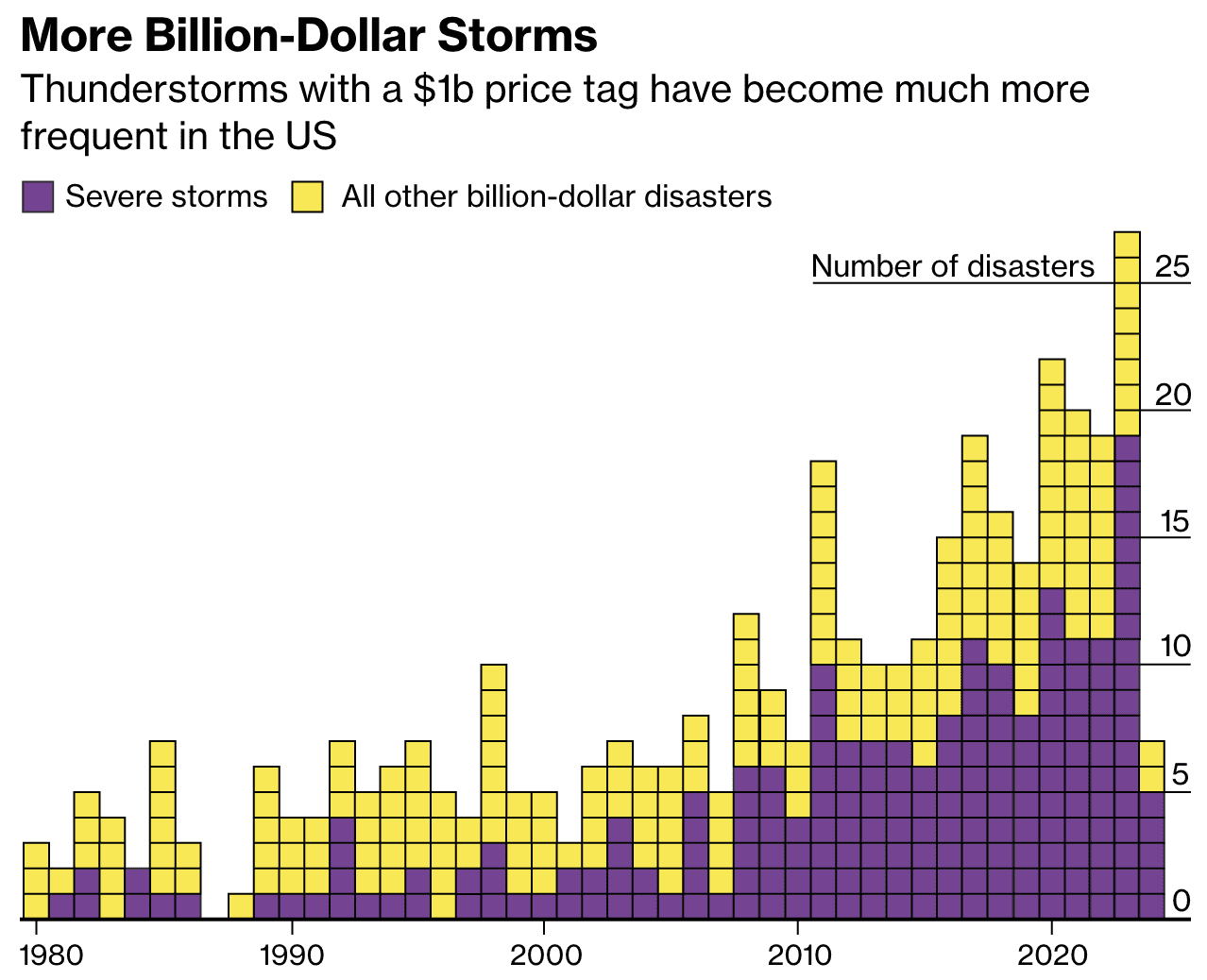Severe weather events are becoming increasingly common and with some preparation, your shop can become a go-to resource for customers in need and bolster your bottom line.
Nearly twenty severe storms in the U.S. caused more than a billion dollars in damage from lightning, hail, and damaging winds in 2023. While these storms may not always capture national headlines, their increasing frequency is causing a massive increase in insurance claims—including those for automotive hail damage.

Storms are becoming more severe and perhaps more frequent. Source: Bloomberg
Unfortunately, 2024’s storm season is on par with last year’s. Between January and May 2024, there were 11 billion-dollar disasters, including DVD-sized hail in Hockley County, Texas, and baseball-sized hail in the Denver Metro area.
While high winds and flooding play a part, hail is the single most costly component of severe storms, accounting for 50% to 80% of damages. The most affected states include Texas, Colorado, Nebraska, Kansas, Minnesota, and Illinois.
Download our Exceptional Customer Service Checklist to build trust, loyalty, and repeat business with your customers.
Just how costly are these hailstorms?
Colorado’s most expensive insured disaster wasn’t a snowstorm but a hailstorm in May 2018. The fast-moving storm hit at the beginning of rush hour, leading to an estimated 150,000 auto insurance claims and more than $2 billion in damages.
Across the U.S., hailstorms cause $8 billion to $14 billion per year in insured losses. These figures rise as storms become more severe and populations increase in urban corridors, especially in Texas and Colorado.
Common Weather-Related Vehicle Issues
Many drivers aren’t prepared for severe weather, including extreme heat waves, so this may be an opportunity to maximize profit in your shop for a variety of different services. When outdoor temperatures reach 100 degrees for an extended period, temperatures under the hood can soar to over 200 degrees. This can lead to strange problems that customers (and technicians!) might not expect.
For example, older batteries may suddenly die as battery fluid evaporates, damaging the battery’s internal structure. Customers experiencing these issues may require roadside service to replace their batteries and get back on the road.
Another common Summer-season issue is an overheated engine. If a customer hasn’t kept up with oil changes, they may have insufficient antifreeze and coolant levels in their engine. During a heat wave, this can quickly lead to an overheated engine and a need for roadside assistance.
Finally, customers who put off other repairs may find them necessary during a heat wave. For instance, an ineffective air conditioning unit may be bearable during the winter or temperate weather, but a heat wave makes it an essential repair.
How to Take Advantage of Severe Weather Conditions
Extreme weather events present a unique opportunity for shop owners to provide valuable services to their customers. By helping your community during a time of need, you can build stronger relationships, enhance your shop’s reputation, and improve your bottom-line performance.
- Know the Forecast Ahead of Time. Following the weather forecast ahead of time for predicted conditions can help you stay ahead of these trends and position your shop as a resource for customers in need.
- Labor, Parts & Tools. Ensure you have the tools and resources to complete repairs and increase throughput efficiently. And, if possible, establish a source of temporary labor to meet an increase in demand.
- Increase Capacity. Develop a plan to temporarily increase capacity in the event of a storm. For example, you may convert part of a parking area into a mobile workshop or rearrange the garage to accommodate more vehicles.
- Prepare Marketing. Create social media, flyers, and other marketing materials that you can send after a hailstorm to reach potential customers. By preparing in advance, you can reach customers more quickly after the storm. A timely discount for hail repair can make all the difference in converting customers.
- Strategic Discounts. Consider offering discounts for air conditioning services for customers who are on the fence about a summer repair. Or offer a summer tune-up that involves battery testing, anti-freeze top-offs, and new windshield wiper blades.
What Services to Provide During Severe Weather
- Cooling System Checks. Offer a special on cooling system checks and maintenance. Ensuring radiators, fans, and coolant levels are in top condition can prevent overheating and keep vehicles running smoothly.
- Battery Health Assessments. Educate customers on how extreme heat can affect battery life and offer complimentary or discounted battery checks.
- Air Conditioning Services. Promote your A/C services by emphasizing the importance of a well-functioning system for comfort and safety during a heatwave.
- Educational Workshops. Host workshops or informative events showing customers how to protect their vehicles during a hailstorm.
How to Keep Your Business Safe
Now that you’re ready to help customers during severe weather, let’s prep your business. You can safeguard your businesses during severe weather by implementing comprehensive preparedness plans. This includes securing all equipment and vehicles inside sturdy buildings or covered areas to prevent damage from high winds or flooding.
Installing storm shutters, reinforcing doors, and ensuring the roof is in good condition can protect the facility’s structure. It’s also crucial to have an emergency response plan, which involves clear communication channels with employees and customers, a backup power supply, and securing important documents and digital data offsite or in the cloud. Regularly reviewing and updating insurance policies to cover severe weather incidents can provide financial protection and peace of mind.
The Bottom Line
Severe weather events are becoming increasingly common across the United States, leading to more insurance claims and potential business for auto shops. By preparing in advance, you can help more customers and improve your bottom line.
